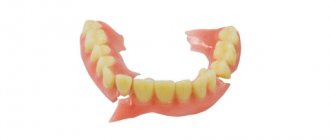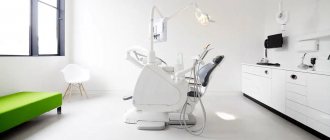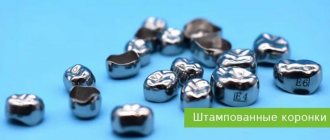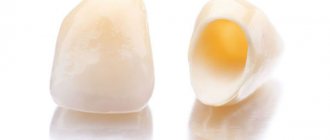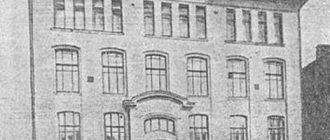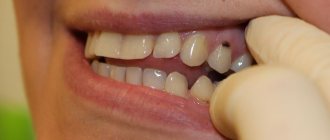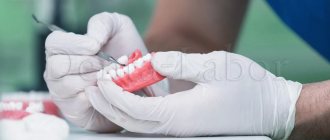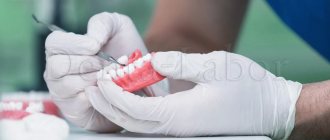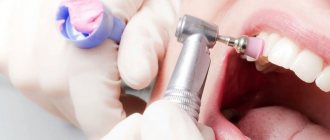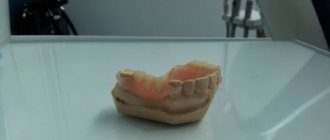Main or preparation room.
This room is designed to perform the basic processes for the manufacture of dentures (modeling, setting teeth, finishing dentures, etc.). The height of the working room must be at least 3 meters. Each worker must have at least 13 m3 of production space and at least 4 m2 of area.
The walls of the main laboratory room should be painted with light-colored oil paint to facilitate their maintenance. The floors should be covered with linoleum. Windows must meet a number of sanitary and hygienic requirements: 1) the light coefficient (the ratio of the glazed surface of the window to the floor area) is provided for at least 1/5; 2) windows should be located at an equal distance from each other and from the corners of the building; 3) the upper edge of the window should be as close as possible to the ceiling (20-30 cm); 4) window sashes should be narrow and sparse, it is better if they are solid glass; 5) the permissible angle of incidence of light rays formed by a beam of light and a horizontal plane, i.e. its inclination to the horizon, at the workplace is at least 25-27 degrees; 6) workplaces should be positioned so that the light falls directly or on the left side of the worker; 7) the distance of the work place from windows in rooms illuminated by natural side light should not exceed three times the distance from the floor of the room to the upper border of the window opening; the maximum width illuminated by windows on both sides of the room should be practically 15-18 meters.
Fulfilling all these requirements is of great importance for the health of dental technicians, since they perform delicate jewelry work with constant eye strain. When equipping laboratory premises, it is necessary to provide special ventilation units (supply and exhaust), hot and cold water supply with mixer taps. Concealed electrical wiring of the lighting and technical network must also be provided for each workplace.
Pros and cons of the clinic’s own laboratory
After taking impressions of the jaws, the patient goes home, and the work on creating the prosthesis is just beginning. In order to fully understand all the advantages of a modern dental laboratory, especially if it is located at the clinic, let's look at what advantages can be derived from such a tandem:
- a dental technician can be present at the discussion of prosthetic options: for example, if, due to a complex clinical picture, the orthopedist has difficulty choosing a model/design of prosthetics, then the dental technician takes part in the consultation and helps to choose the best option,
- the possibility of correcting dentures directly at a dentist’s appointment: at different stages of the manufacture of prosthetic structures, it is necessary to try it on, and in some cases, adjustments - the experience of a dental technician observing the fitting process will be useful in this. A specialist who manufactured a prosthesis in a third-party organization rarely has the opportunity to be present in a doctor’s office when trying on structures for patients. Or such a visit will need to be paid according to the price list,
- no risk of damage to the prosthetic device during transportation to the clinic,
- quick interaction between the patient, dentist and technician: the orthopedist will always be able to promptly answer questions - what the prosthesis will be made of, what technology will be used, and how long to wait,
- reduction in the production time of the prosthesis: patients of the clinic with its own dental department restore their smile in the shortest possible time,
- savings on treatment: no extra charge from a third-party manufacturer, no transportation costs for delivery (and multiple times - if adjustments are required after trying on),
- long-term warranty for a prosthetic or orthodontic device: reflected in the contract that the clinic necessarily concludes with the patient.
The disadvantages include the fact that there are still very few truly innovative institutions of this kind that purchase only high-quality raw materials and regularly update equipment. Machines and devices for production in a dental laboratory are quite expensive, and in order for the costs to be quickly recouped, you need to receive many orders - i.e. have a large staff, regularly purchase expensive materials and consumables.
Don't know what type of prosthetics to choose?
We will help in the selection, advise where to read more information and compare types of prosthetics.
Consultation with an orthopedic doctor in Moscow clinics is free! Call now or request a call
Working hours: from 9:00 to 21:00 - seven days a week
It’s easier for residents of large cities, because there will be at least one modern denture shop nearby. Therefore, in order for the patient’s expectations to coincide with reality, you need to be very careful when choosing a dentist and clinic. If an orthopedist from a small town orders the production of complex dentures, ceramic inlays or veneers in a modern laboratory (even if it is located far away), then the restoration of teeth from this doctor will be high-quality and long-term.
Workplace of a dental technician.
For the convenient, fast and most efficient implementation of all processes associated with the manufacture of dentures, each dental technician must have an individual workplace, which consists of a laboratory table, the surface of which should be marble or, at a distance of 20 - 25 cm from the edge of the table, covered with sheet brass or stainless steel. The surface of the table has a semi-lunar cut-out, in the center of which there is a special cut-out for trimming models - a finagel. Directly below the cutout there are one or two drawers for storing tools and collecting waste of plaster, plastic, metal scraps, etc.
On the right side of the laboratory table there are bedside tables for storing models, materials, prostheses at different stages of manufacturing, etc.
On the surface of the table there is a lighting device on the left or directly above the table, a cable motor or a specially built-in drill, a gas burner, an electric spatula for heating wax and other operations related to wax.
Each workplace must have ventilation (exhaust).
A chair for a dental technician should have a swivel backrest.
Great importance should be attached to the design of the dental technician’s workplace, since this is where he spends most of his working time, and it must meet all the requirements of ergonomics and occupational safety and health. Along with technical requirements, elements of aesthetics and modern design must also be taken into account.
Dental laboratory
PREMISES, WORKPLACE AND INSTRUMENTS
In the denture laboratory, which is part of the orthopedic department or office, dentures and devices are manufactured.
Room. The laboratory must have one main room and a number of auxiliary rooms. In the main room there are work tables equipped with equipment and tools for making dentures. In the same room there is a fume hood and equipment for soldering metal prostheses.
The utility rooms house:
- 1) plaster and polishing machines, intended for plastering models and polishing prostheses; Usually in the same room polymerization of plastic prostheses and vulcanization of rubber ones is carried out;
- 2) molding room, in which plastic prostheses are molded and rubber ones are packed; it is located next to the plaster room; the room in which the molding room is located must be bright;
- 3) foundry, designed for casting parts of prosthetics from steel.
In terms of fire safety, it is advisable to place the foundry separately from the main room.
Workplace. The efficiency of work largely depends on the proper organization of the dental technician’s workplace. With a rational arrangement of the work table, the availability of appropriate equipment and tools, the productivity of the dental technician increases. The lack of everything necessary at hand not only reduces the intensity of work, but also affects the quality of work.
The work table in a dental laboratory should be 75-80 cm high, so that it is comfortable to work while sitting.
A small semicircular cutout is made in the center of the desktop, the edges of which are edged with sheet brass or stainless steel; the surface of the table at a distance of 20-22 cm from the middle of the cutout is also upholstered with steel or brass; a wooden ledge is attached to the edge of the table (Fig. 1).
In the center of the table there should be one deep drawer for storing tools, under this drawer there should be a retractable plywood board for collecting sawdust of gold and other metals, as well as wax waste. A second box, shallower than the first, will be placed under the board to collect plaster waste. On the side there is a bedside table with shelves where materials and manufactured prostheses are stored.
The work desk should be well lit. Artificial lighting should not be harsh, and only the workplace should be illuminated.
Tools. On the right side of the workplace, usually above the bedside table, a dental grinding motor is installed. The grinding motor has a double-sided axis, on one end of which a tip is put on for securing carborundum stones, cutters and burs; with their help, teeth are sharpened, dentures are finished, etc. The opposite end of the grinding motor axis is equipped with a conical coupling with a screw thread; felts, lugs and guns necessary for grinding and polishing dentures can be attached to the coupling (Fig. 2). However, it is more advisable to carry out grinding and polishing in another room, so as not to pollute the air with dust from abrasive materials and pastes used for grinding and polishing dentures.
If necessary, the conical coupling can be replaced with a handpiece and the grinding motor can be used simultaneously by two technicians.
If you do not have a dental grinding motor, you can use a foot grinder.
The grinding machine consists of a massive metal stand with a movable table, which lowers and rises depending on the height of the worker; The table has a drawer for storing polishing materials. In the center of the table there is a fixed metal stand with a head, which has a two-way axis and serves the same purpose as the grinding motor. In the middle of the axis of the head there is a small grooved pulley, which is connected to a large grooved wheel by means of a belt; this wheel is located at the bottom of the rack and rotates around a horizontal axis. connecting both walls of the rack. The large wheel is driven t: movement by means of a pedal connected to it (Fig. 3). A gas burner is brought to the work table. If there is no gas, use an alcohol lamp.
To work, you must have a minimum set of small tools: a dental spatula, tweezers, crown scissors, dental forceps, dental hammers, a dental anvil, files and a rubber cup stirrer for mixing plaster.
A drain spatula is a two-pointed knife with a wooden handle in the middle, one end of which is sharp and. the other is blunt and somewhat curved. The spatula is intended for modeling teeth, wax rolls, bases, melting wax and trimming plaster. To trim hardened models, in addition to a dental spatula, use a massive, pointed plaster knife (Fig. 4).
Dental tweezers resemble anatomical ones, but their ends are not blunt, but pointed and without internal notches (Fig. 5).
Crown scissors have curved ends to make it easier to trim the edges of metal crowns. In addition to curved ones, straight pointed scissors are also used. They are also convenient for cutting sheet metal, solder, rubber, etc. (Fig. 6).
Plaster room.
In the plaster room, all casting of models, plastering into the occluder, plaster of prostheses into cuvettes before polymerization, release of prostheses from the plaster mold, etc. are carried out. The room contains a large table, the surface of which is made of metal. Hot and cold water is supplied to the table. A hopper for storing gypsum, a press for squeezing gypsum out of ditches, and a regular press are installed on the table. Cuvettes, an occluder, articulators and other equipment and instruments are stored in table drawers or on shelves.
What types of prostheses can be made?
Modern dental facilities must be equipped with all the necessary equipment and tools for creating orthopedic and orthodontic products of any known type:
- classic metal crowns and bridges: despite the poor aesthetics, such prosthetics are still used due to their low cost,
- metal-ceramic metal-free and ceramic crowns and bridges: made of porcelain (as a coating), lithium disilicate, aluminum dioxide or zirconium. This is one of the most popular trends - high-quality and aesthetic,
- ceramic inlays: a kind of “hybrid” of a filling and a partial crown,
- removable orthopedic devices: butterfly prostheses, plate prostheses, Acry-free, Quattro Ti, clasp prostheses of any type (with hooks, clasps and telescopic crowns),
- orthodontic plates,
- veneers and ultra-veneers: these onlays are designed to create a “Hollywood” smile (lumineers are not created in the laboratory - they are developed by the Cerinate company, and the onlays themselves are sent from the USA to the clinic after being manufactured individually for the patient),
- prostheses and individual abutments for fixation on implants,
- temporary crowns, bridges and complete orthopedic structures,
- metal beams for fixing implants and metal-free frames.
%akc57%
Molding and polymerization room.
In this room, plastic is prepared, molded and polymerized.
In the room there is a table designed for preparing dough from various plastics and molding it into cuvettes. The table should have a smooth surface that is easy to clean. One or two dental presses are placed on the table to press plastic dough into cuvettes before tightening them into clasps. There should also be a hermetically sealed vessel on the table to collect plastic residues after molding into cuvettes in order to reduce the evaporation of methyl methacrylate.
At least two open-type sterilizers or similar devices are installed on a gas stove. One of them is used for melting wax from cuvettes, the other for polymerizing plastic. An exhaust probe (hood) of the ventilation unit must be installed above the table and gas stove.
Polishing room.
This room houses tables with several cable motors for polishing prostheses made of metals and alloys. A dust collector for polishing dentures made of precious metals (gold, silver-palladium alloys) is installed separately, since all dust, polishing paste, sandpaper and other materials used for finishing, grinding, polishing precious metals are collected and delivered to a metal recycling plant for extraction from of them metals in their pure form. All loop motors are supplied with a powerful dust collection system and good lighting.
The soldering room is equipped with one or more fume hoods, where soldering apparatuses are installed, equipped with compressors for automatic gasoline supply. Fume hoods also usually house a muffle furnace for melting wax from flasks when casting parts from precious metals. In the cabinets, individual parts of test runs are soldered, and they are bleached after soldering. The soldering room is also provided with powerful exhaust ventilation.
Foundry room.
For high-quality production of modern prosthetic designs, such as bridges, metal-ceramic, clasp, etc., individual casting is required, where the components of such prostheses are cast in lost wax molds individually for each patient.
Wide possibilities for the manufacture of such prostheses have opened up thanks to the creation of an original installation, where high-frequency induction melting of metal alloys is combined with centrifugal casting and new technology for preparing casting molds. Using induction currents, you can melt any metal used for the manufacture of crowns, bridges and clasp dentures, removable denture bases, implants, splints in the treatment of periodontal diseases.
Features of the profession
This profession is considered technical and is somewhat similar to the work of a jeweler. Almost always, the product is modeled by hand, individually for each patient, and must perform the functions assigned to it: exactly suit the patient’s needs, have an aesthetic appearance, high-quality durable materials are used in the work.
Design modeling begins with working on a dental wax model. Only after checking all the parameters is the model converted to metal, ceramics or composite.
A dental technician uses knowledge from various sciences in his work: physics, chemistry, anatomy. He needs the skills of a mechanic, a milling machine operator, a galvanizing chemist, and a welder. And modern technologies require knowledge of 3-D computer graphics.
Due to the nature of the profession, the tools used in the work are also very diverse: anvils, machines for stamping crowns, jigsaws, hammers.
Profession risk
Often the manufacture of such structures involves inhalation of harmful chemicals. For these reasons, the technician wears protective gloves, a mask and goggles.
Regularly, every two to three years, a dental technician undergoes advanced training courses to become familiar with new technologies and materials. Today this is a very popular profession, since a beautiful smile is the desire of every sane person.
Obtaining a specialty
The specialty of a dental technician is called “orthopedic dentistry”, and it is obtained in secondary medical institutions, and the training itself lasts exactly as long as indicated in the program and at this moment the course is 2 years and 10 months. Admission is usually carried out on a competitive basis based on the results of the Unified State Exam and special attention should be paid to the Russian language, physics and chemistry. You can enroll in secondary education at any medical college that has the required faculty.
While a student is studying to become a dental technician, he will need to study many disciplines and gain all the necessary skills, and among them the most relevant are:
- Creation of removable and non-removable dentures;
- Manufacturing of orthodontic and maxillofacial structures;
- Foundry;
- Modeling.
In addition, the profession of a dental technician is one of the medical specialties where they teach not only the main type of activity, but also what is useful in other areas, namely:
- Genetics;
- Topographic anatomy;
- Pharmacology;
- Physiology;
- Surgery;
- Knowledge of Latin;
- Therapy.
The student will learn not only by sitting in lectures, but also by consolidating the acquired knowledge in a practical form, being in the laboratory and creating prosthetics of varying complexity. Of course, all this will happen under the close supervision of teachers and specialists in their field. Using this method of learning, the student will better understand the essence of the process, and will also get used to working with various materials.
After graduation, a young specialist has three areas where he can prove himself and start earning money, namely:
- medical and preventive care;
- management activities;
- production and technological business.
